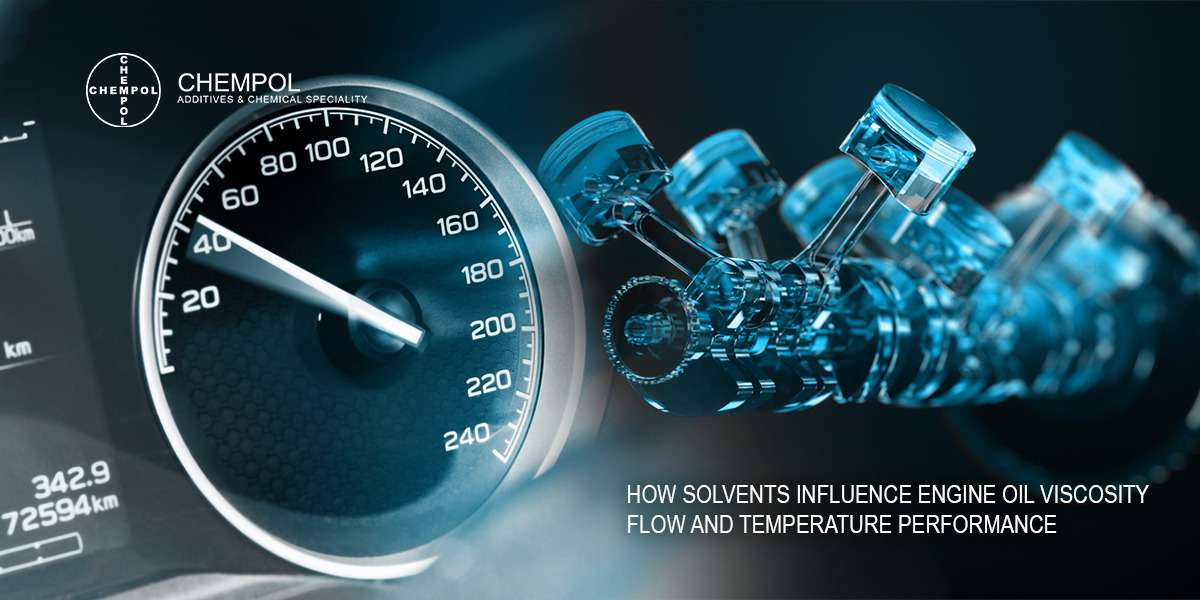
How Solvents Influence Engine Oil Viscosity Flow and Temperature Performance
This work investigates the effect of solvent polarity on lubricants’ viscosity and viscosity index while using ethanol as a polar solvent and toluene as a non-polar solvent. The experiments were performed at different solvent ratios and varying temperatures and at five different temperatures, including 100 C. The results also indicate that engine oil mixed with a non-polar molecule provides more temperature stability compared to a polar molecule, with viscosity index values of 366 and 580, respectively.
The smooth operation of your car’s engine hinges on a critical part: engine oil. This lubricant oil reduces friction, protects against wear and tear, and cools engine parts. But did you know that the oil’s “thickness” or viscosity can significantly impact its performance, and this “thickness” isn’t constant, changing with temperature? The viscosity index (VI) offers a valuable measure of how well the oil maintains its thickness across different extreme cold or hot temperatures.
This analysis gives insights into the world of engine oil viscosity. It explores how the addition of different solvents, namely ethanol (polar) and toluene (non-polar), affects its viscosity and VI:
The activation energy of viscous flow (Ea) is calculated using the Arrhenius viscosity-temperature dependence. The result comes in values of 42128, 29256, and 35417 KJ/mole for lubricating engine oil mixed with ethanol, toluene, and no additives, respectively.
The Experiment Of Mixing Ethanol Or Toluene To See What Flows
Fill beakers with engine oil and varying amounts of ethanol or toluene to obtain proper results for additives using the Arrhenius formula. These mixtures are then subjected to different temperatures, ranging from ambient to a scorching 100°C. Then, carefully measure the oil’s viscosity throughout this temperature, capturing how “thick” it becomes at each point.
The Big Revelation of the Solvent’s Influence

Adding ethanol, a type of alcohol, to oil makes it thicker (increases its viscosity). This happens because the ethanol molecules stick to the oil molecules, making it harder for them to flow. On the other hand, adding toluene, another type of liquid, has the opposite effect. It thins the oil (decreases its viscosity) because its molecules don’t stick to the oil molecules as strongly.
The addition of a polar solvent, such as ethanol, to lubricating engine oil increases viscosity due to the strong intermolecular forces, such as hydrogen bonding, present in polar molecules.
Temperature’s Impact: The Hotter, the Thinner (Usually)
As expected, all the oil mixtures thinned out as the temperature rose. This is a general rule for most liquids – heat excites the molecules, making them vibrate and wiggle more, leading to less resistance to flow. However, the extent of this thinning varied depending on the solvent. Interestingly, engine oil mixed with toluene showed greater temperature stability, meaning its viscosity changed less drastically with temperature fluctuations. This stability is reflected in its higher VI, a number indicating how well an oil maintains its viscosity across a temperature range.
Why Does It Matter If Putting All The Elements Together
It is needed to understand how solvents influence the oil viscosity and why VI is crucial for several reasons:
Choose The Right Oil
Different engines operate in different regions where temperatures are at varying degrees. Thus, these engines require specific oil with viscosity characteristics. Knowing how solvents affect the VI will help us select the optimal oil for each engine. It also ensures proper lubrication and protection under varying operating conditions.
Oil Formulations:
Oil and lubricant manufacturers can leverage this knowledge to design engine oils with viscosity index improvers properties using specific solvent additives. This could lead to oils that offer fuel efficiency, reduce emissions and improve the performance of oil.
Understand Oil Degradation:
As oil ages and breaks down, its viscosity can decrease. We can get an insight into the oil’s health and determine when it needs to be replaced.
The addition of a non-polar solvent, like toluene, decreases viscosity due to the small size of toluene and the presence of dispersion intermolecular forces, which are also present in paraffinic lubricating oil.
Effect of Solvent Polarity on Viscosity:

The polarity of a solvent has a significant effect on the viscosity of lubricating engine oil.
Adding a polar solvent, such as ethanol, to lubricating engine oil increases viscosity. This is due to the strong intermolecular forces, such as hydrogen bonding, in polar molecules.
It is widely accepted that engine oil changes shape at elevated temperatures. It hinders engine performance and provides less protection. Thus, the remedy devised by scientists is to incorporate minuscule particles that slide between the oil molecules. These particles maintain their smoothness despite the increase in temperature. This aids in safeguarding the engine against any potentially hazardous elements. This improves the lubrication and engine protection provided by the oil.
Curious and enthusiastic about discovery, scientists are experimenting with various quantities and varieties of these aids to determine which is most effective. How would it be possible to produce a lubricant that flows flawlessly at any temperature while maintaining the engine’s health and happiness?
Future studies are brimming with exciting possibilities. Or it can even be a whole new generation of oils made with cutting-edge materials and technology.
The goal is to create smoother, cleaner, and more efficient engines by understanding how oil thickness and temperature response work. This will lead to improvements for future engines.
By gaining an understanding of how oil thickness and temperature response function, the objective is to develop engines that are more efficient, cleaner, and that run more smoothly. Because of this, changes will be made to engines in the future.
Exploration Opportunities Are Present

The findings of this research point to potentially fruitful directions for additional investigation of viscosity index improver polymer! Researchers can determine how the viscosity of oil and its temperature response (VI) are affected by the different solvents used via experimentation by adjusting the quantity and type of solvents used. This may result in enhanced additives that are suited to exact requirements.
Additionally, different engine components require different pressure settings in order to function properly. The creation of lubricants that offer the best possible protection for these components might be facilitated by conducting research into the characteristics of oil thickness and temperature response on these components.
Diesel Engine Oil Additives provide a world of possibilities beyond conventional lubricants in the pursuit of improved performance. The next generation of revolutionary materials and technologies has the potential to outperform even the most efficient lubricants now available on the market.
The ultimate objective is still to make engines smoother, cleaner, and more efficient. It is essential to comprehend the relationship between oil thickness and temperature response in order to develop engines in the future. Diesel engine oil additives are essential to the effort to increase engine life and performance.
Continue The Journey and Explore: https://chempol.co.uk


